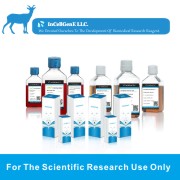

Overview
| Organism | Homo sapiens, human |
|---|---|
| Tissue | ureter, uroepithelium |
| Cell Type | epithelial SV40 immortalized |
| Product Format | frozen |
| Morphology | epithelial |
| Culture Properties | adherent |
| Biosafety Level |
2 [Cells contain Adenovirus]
Biosafety classification is based on U.S. Public Health Service Guidelines, it is the responsibility of the customer to ensure that their facilities comply with biosafety regulations for their own country. |
| Age | 11 years |
| Gender | male |
| Storage Conditions | liquid nitrogen vapor phase |
| Disclosure | This material is cited in a US or other Patent and may not be used to infringe the claims. Depending on the wishes of the Depositor, ATCC may be required to inform the Patent Depositor of the party to which the material was furnished. This material may not have been produced or characterized by ATCC. |
Properties
| Karyotype |
The chromosome number distribution is bimodal with 50% of the cells near diploid (mode = 44 chromosomes) and 50% tetraploid (mode = 88). Both populations consistently showed seven marker chromosomes: 5p+, del(6)(p11), 9q+, 11p+, 15q-, 19p+ and Xp+. Most cells lacked a normal chromosome 15. Cells in the tetraploid population did not exactly duplicate the diploid population in that most had a 14q/21 translocation involving two chromosomes 14 and two chromosomes 21, while the diploid cells had normal chromosomes 14 and 21 and a 6q/14q translocation. |
|---|---|
| Derivation |
This line was established by transformation of normal ureter tissue with SV40 virus.
A chemically transformed tumorigenic derivative of this cell line is available (MC-SV-HUC T-2, see ATCC CRL-9519). |
| Clinical Data |
male
11 years
|
| Genes Expressed |
uroepithelial keratins; SV40 T antigen
|
| Cellular Products |
uroepithelial keratins; SV40 T antigen
|
| Tumorigenic | No |
| Effects |
No, nude mice
|
| Comments | The line has been repeatedly tested for production of infectious SV40 using an African Green Monkey kidney cell plaque assay, and has always tested negative. Stress (such as chemical exposure) could possibly activate the virus. |
Background
| Complete Growth Medium |
The base medium for this cell line is ATCC-formulated F-12K Medium, Catalog No. 30-2004. To make the complete growth medium, add the following components to the base medium: fetal bovine serum to a final concentration of 10%. |
|---|---|
| Subculturing |
Volumes used in this protocol are for 75 cm2 flask; proportionally reduce or increase amount of dissociation medium for culture vessels of other sizes.
Subcultivation Ratio: 1:2 to 1:5 Note: For more information on enzymatic dissociation and subculturing of cell lines consult Chapter 10 in Culture of Animal Cells, a Manual of Basic Technique by R. Ian Freshney, 3rd edition, published by Alan R. Liss, N.Y., 1994. |
| Cryopreservation |
Complete growth medium, 95%; DMSO, 5%. Cell culture tested DMSO is available as ATCC Catalog No. 4-X.
|
| Culture Conditions |
Temperature: 37��C
|


